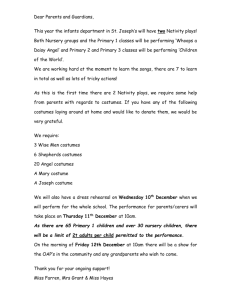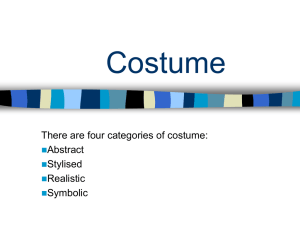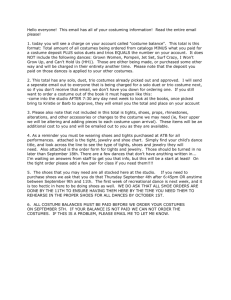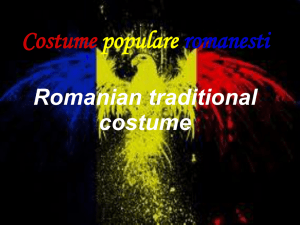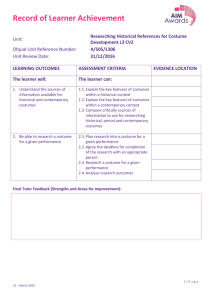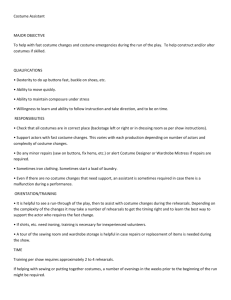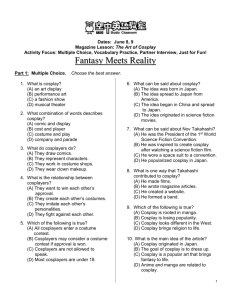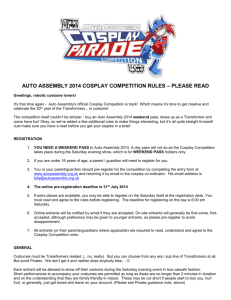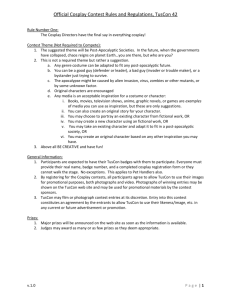Requirements Analysis
advertisement
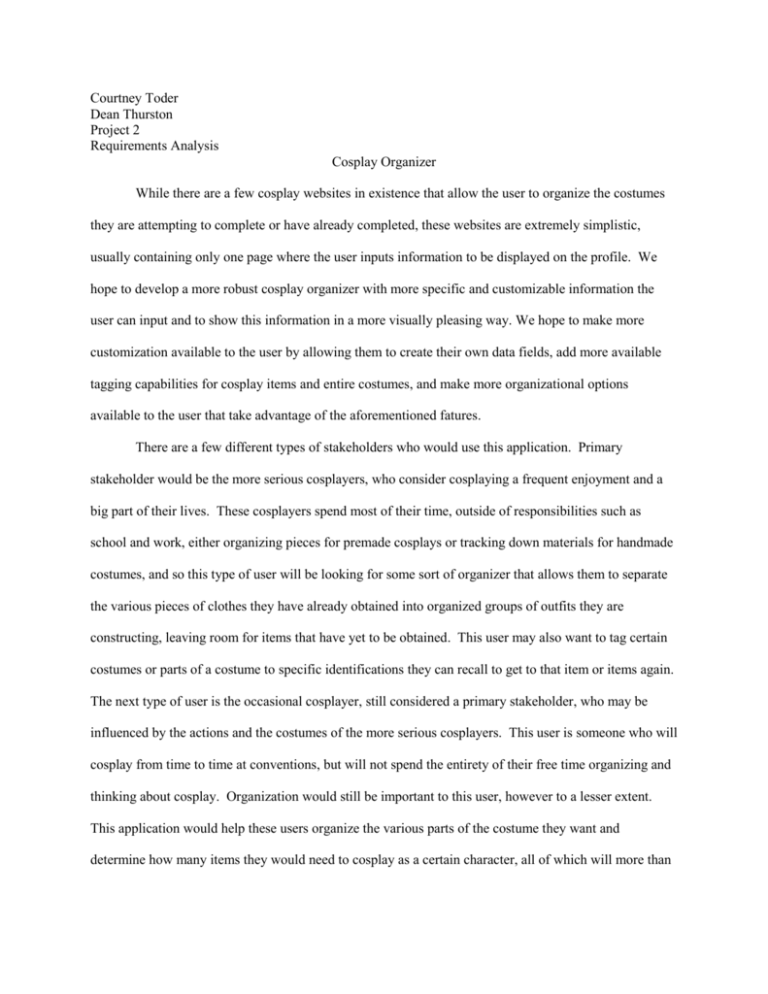
Courtney Toder Dean Thurston Project 2 Requirements Analysis Cosplay Organizer While there are a few cosplay websites in existence that allow the user to organize the costumes they are attempting to complete or have already completed, these websites are extremely simplistic, usually containing only one page where the user inputs information to be displayed on the profile. We hope to develop a more robust cosplay organizer with more specific and customizable information the user can input and to show this information in a more visually pleasing way. We hope to make more customization available to the user by allowing them to create their own data fields, add more available tagging capabilities for cosplay items and entire costumes, and make more organizational options available to the user that take advantage of the aforementioned fatures. There are a few different types of stakeholders who would use this application. Primary stakeholder would be the more serious cosplayers, who consider cosplaying a frequent enjoyment and a big part of their lives. These cosplayers spend most of their time, outside of responsibilities such as school and work, either organizing pieces for premade cosplays or tracking down materials for handmade costumes, and so this type of user will be looking for some sort of organizer that allows them to separate the various pieces of clothes they have already obtained into organized groups of outfits they are constructing, leaving room for items that have yet to be obtained. This user may also want to tag certain costumes or parts of a costume to specific identifications they can recall to get to that item or items again. The next type of user is the occasional cosplayer, still considered a primary stakeholder, who may be influenced by the actions and the costumes of the more serious cosplayers. This user is someone who will cosplay from time to time at conventions, but will not spend the entirety of their free time organizing and thinking about cosplay. Organization would still be important to this user, however to a lesser extent. This application would help these users organize the various parts of the costume they want and determine how many items they would need to cosplay as a certain character, all of which will more than likely be more simplified for this user when compared to the elaborate nature of more professional cosplayers’ costumes. A secondary stakeholder for this system could be someone who manufactures costumes or costume pieces. By analyzing what people need and what costumes they are constructing, they can assess demand for a specific costume or piece and offer to create it, or renew stock if the item has been created previously. Many people who make their own cosplay costumes may also create costumes for other people, using sites like ebay and etsy to sell their creations. If a potential customer were to send a sort of audit of their cosplay profile to send to a commissioner, it could possibly make the job go incredibly smoothly because it lists in detail what pieces are needed, and may even store reference images for the commissioner to refer back to that have been handpicked by the cosplayer asking for the costume. Commissioners frequently run into problems with customers who do not provide enough detail or high quality reference photos, and are often blamed for mistakes that could have been prevented if they had been given correct information. The average commissioner spends most of their time working on cosplays for other people, and so would benefit from clear and concise information provided by the information in the cosplay application. Tertiary stakeholders are a bit harder to define for this application, seeing as how cosplay is a rather personal hobby, and not an industry in itself. However, perhaps a tertiary stakeholder could be the organizers of panels at conventions. Frequently, cosplayers will cosplay characters from their favorite games and anime series, rarely ever choosing characters they know nothing about. Knowing this information, panelists may be able to determine what series are the most popular at any given time, and therefore appropriately prepare panels that reflect the most popular interests of convention attendees. This would prevent panels from paying too much attention to niche series, and would perhaps even help guarantee a minimum attendance of any given panel. Panelists are usually fans of series that attend the con as cosplayers themselves, and want to provide a fun experience for fans of similar interests. One important task that users can accomplish is inputting information for a completely new cosplay. This would entail creating a new file in their personal cosplay database, and inputting all relevant information, including custom fields and tags. As an example, let us use the cosplayer Marla. Marla has just gotten a new costume today, and has almost everything she needs now, but the skirt of the costume feels too big and will not stay up. She will need to purchase just a few accessories for the costumer, and get the skirt taken in. She wants to enter this information into the database so she can keep track of what she still needs to buy and fix up. She goes to the database and creates a new file, which she names “Tohru Honda (Summer)” from the anime Fruits Basket. She the clicks each field she wants to put information into, including the list of finished pieces, the list of unfinished pieces, and the list of reference images. She tags this cosplay as anime, manga, and shoujo. Upon saving this information, she pulls up the list of unfinished pieces and begins to look up websites to purchase what she needs. The hierarchy for this task can be described as follows: 1. Enter database 2. Create new file 3. Fill in fields a. Create name b. Specify series c. List finished pieces d. List unfinished pieces e. List conventions this costume has been or will be worn to f. Link to or save reference images g. Create and fill in custom fields 4. Tag costume 5. Save file A simpler task than this could involve a user accessing a certain file to do what Marla started at the end of the last user story, which is begin to search for materials that are still needed. In this example, we will use the cosplayer Ethan. Ethan has already made a file for his Pokemon cosplay, but knows that he is missing a few important pieces. He pulls up the file for this costume by searching under the Pokemon tag. He sees two cosplays under this tag, and selects the one for the costume he is currently working on. He clicks on the field that lists necessary pieces, and begins to search for these pieces online. This task may look something like this: 1. Enter database 2. Search for costume a. Type keyword into search bar b. Select a specific field to search under or keep it general c. Click search to see results 3. Browse search results 4. If desired costume does not appear in results, alter search from step 2 5. Select result that is the desired costume 6. Select desired field to see in greater detail A third user story that is possible with this program represents the organizational aspect of the application. The task described here will be creating a “closet” out of preexisting costumes in the database. For this example, we will use the cosplayer Sean. Sean has cosplayed three costumes in two years at AnimeNEXT, and wants to make a closet of those costumes to keep track of what has been worn to AnimeNEXT. He selects the “create closet” option, and names the closet “AnimeNEXT Costumes.” He searches under the AnimeNEXT tag, and selects each costume. For each costume, he selects the option “add to closet” and selects the closet he just created. After going through each of the results and repeating this, he now has a closet with three costumes in his database. This process goes as follows: 1. Enter database 2. Create closet a. Select “create closet” option b. Name closet as desired 3. Search for costumes to be put in closet 4. Add costume to closet a. Select desired costume b. Select the option “add to closet” c. Select closet to add costume to 5. Repeat step 4 until all desired costumes have been added to the closet In order to use this system, the user must be familiar with some simple cosplay terms, including the term cosplay itself. Users must be able to accurately input information, being careful not to confuse the list of pieces still required and pieces already completed. Users should also know to separate a costume into individual pieces to begin with, and not just focus on the costume as a single entity, as this defeats the purpose of the separate piece lists. Finally, users must be familiar with the source material of their costume, as this is what allows for much more descriptive tags, and therefore a greater ability to search for individual costumes and closets of costumes.
